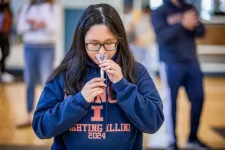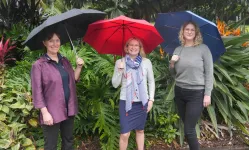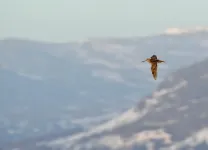INFORMATION:
Further information
Title: RAS-inhibiting biologics identify and probe druggable pockets including an SII-α3 allosteric site
DOI: 10.1038/s41467-021-24316-0
For further details contact Ian Rosser in the University of Leeds press office i.rosser@leeds.ac.uk
New treatment options for deadliest of cancers
2021-06-30
(Press-News.org) A new way to target a mutant protein which can cause the deadliest of cancers in humans has been uncovered by scientists at the University of Leeds.
The mutated form of the RAS protein has been referred to as the "Death Star" because of its ability to resist treatments and is found in 96% of pancreatic cancers and 54% of colorectal cancers.
RAS is a protein important for health but in its mutated form it can be switched on for longer, leading to the growth of tumours.
One drug has already been approved for treatment but it can only tackle a small subset of the total number of cancers driven by RAS.
Now a team from the University of Leeds' School of Molecular and Cellular Biology has gone further and found a new way to target the protein to pave the way for a greater range of treatments for more patients.
Lead author of the report, Dr Darren Tomlinson, of the Astbury Centre for Structural and Molecular Biology, said: "The RAS protein has been referred to as the Death Star with good reason and that's because it's spherical and impenetrable, essentially preventing drugs binding and inhibiting it. We've identified a further chink in the Death Star that can be used to develop new drugs beyond the ones already in development."
The researchers used the School of Molecular and Cellular Biology's own patented Affimer biotechnology platform to pinpoint druggable "pockets" on the protein to allow effective treatment to take place.
The study was funded by the Wellcome Trust, the Medical Research Council, the Technology Strategy Board and Avacta and is published today (30 June 2021) in the journal, Nature Communications.
Dr Tomlinson added: "This work opens up the door for the hundreds of other disease targets. We could effectively probe any protein involved in any disease for druggable pockets in the future."
Co-first author of the report and PhD student, Amy Turner, from the School of Molecular and Cellular Biology, said: "Because it causes 20-30% of all known cancers, RAS really is the Holy Grail of therapeutic targets. The fact that it has previously been termed "undruggable" has allowed us to demonstrate the huge impact that our Affimer technology can have when it comes to treating challenging pathologies. We have already identified small molecules that bind to RAS, so it will be very exciting to be involved in developing these over the next few years."
The researchers say work on expanding more ways to target RAS is still in its early stages but they believe their discovery could lead to new treatments, putting Leeds at the forefront of the fight against cancer.
ELSE PRESS RELEASES FROM THIS DATE:
Lack of exercise while in quarantine had adverse effects on the health of women aged 50-70
2021-06-30
In a study involving 34 women aged 50-70, researchers at the University of São Paulo (USP) in Brazil performed objective measurements of the impact on the subjects' health of the decrease in physical activity observed during the period of social distancing and isolation imposed by COVID-19. Tests conducted after the first 16 weeks of confinement pointed to a deterioration in their overall health, including loss of muscle strength and diminished aerobic capacity, as well as elevated levels of cholesterol and glycated hemoglobin, both of which are risk factors for metabolic disorders.
The study was supported by São Paulo Research Foundation ...
Researchers discuss common errors in internet energy analysis to develop best practices
2021-06-30
When it comes to understanding and predicting trends in energy use, the internet is a tough nut to crack. So say energy researchers Eric Masanet, of UC Santa Barbara, and Jonathan Koomey, of Koomey Analytics. The two just published a peer-reviewed commentary in the journal Joule discussing the pitfalls that plague estimates of the internet's energy and carbon impacts.
The paper describes how these errors can lead well-intentioned studies to predict massive energy growth in the information technology (IT) sector, which often doesn't materialize. "We're not saying the energy use of the internet isn't a ...
Frequent COVID-19 testing key to efficient, early detection, study finds
2021-06-30
CHAMPAIGN, Ill. -- The chance of detecting the virus that causes COVID-19 increases with more frequent testing, no matter the type of test, a new study found. Both polymerase chain reaction and antigen tests, paired with rapid results reporting, can achieve 98% sensitivity if deployed at least every three days.
"This study shows that frequent testing can be really effective at catching COVID-19 infections and potentially blocking transmission," said study leader Christopher Brooke, a virologist and professor of microbiology at the University of Illinois Urbana-Champaign. "There are many places where vaccination is not yet widespread. With the rise of variants, testing remains an important tool ...
New research lifts the clouds on land clearing and biodiversity loss
2021-06-30
QUT researchers have developed a new machine learning mathematical system that helps to identify and detect changes in biodiversity, including land clearing, when satellite imagery is obstructed by clouds.
Using statistical methods to quantify uncertainty, the research, published in Remote Sensing in Ecology and Conservation, analysed available satellite images of an 180km square area in central south-east Queensland.
The region is home to many native species including the critically endangered northern hairy-nosed wombat and the vulnerable greater glider, and the ...
New beetle species found pristinely preserved in fossilized dropping of dinosaur ancestor
2021-06-30
Fossilized feces are common finds at paleontological dig sites and might actually contain hidden treasures. By scanning fossilized dung assigned to a close dinosaur relative from the Triassic period, scientists discovered a 230-million-year-old beetle species, representing a new family of beetles, previously unknown to science. The beetles were preserved in a 3D state with their legs and antennae fully intact. The finding appears June 30 in the journal Current Biology.
The discovery that fossilized droppings, also known as coprolites, can preserve ancient insect species offers a new alternative to amber fossils--fossilized tree resin, which normally yield the best-preserved insect fossils. The oldest ...
During epic migrations, great snipes fly at surprising heights by day and lower by night
2021-06-30
Don't let the great snipe's pudginess fool you. A stocky marsh bird with a 20-inch wingspan, great snipes are also speedy marathoners that can migrate from Sweden to Central Africa in just three days, without even stopping to eat, drink, or sleep. Now, researchers find that the snipes also rise nearly 2,500 meters in elevation at dawn and descend again at dusk each day, perhaps to avoid overheating from daytime solar radiation by climbing to higher, cooler altitudes. The findings appear June 30 in the journal Current Biology.
The birds also spent much more time in higher elevations ...
Researchers look to human 'social sensors' to better predict elections and other trends
2021-06-30
Election outcomes are notoriously difficult to predict. In 2016, for example, most polls suggested that Hillary Clinton would win the presidency, but Donald Trump defeated her. Researchers cite multiple explanations for the unreliability in election forecasts -- some voters are difficult to reach, and some may wish to remain hidden. Among those who do respond to surveys, some may change their minds after being polled, while others may be embarrassed or afraid to report their true intentions.
In a new perspective piece for END ...
Embryo freezing for IVF appears linked to blood pressure problems in pregnancy
2021-06-30
30 June 2021: A large cohort study drawn from the national IVF registry of France, which included almost 70,000 pregnancies delivered after 22 weeks gestation between 2013 and 2018, has found a higher risk of pre-eclampsia and hypertension in pregnancies derived from frozen-thawed embryos. This risk was found significantly greater in those treatments in which the uterus was prepared for implantation with hormone replacement therapies. The results confirm with real-life data what has been observed in sub-groups of patients in other studies.
The results are presented today by Dr Sylvie Epelboin from the Hôpital Bichat-Claude Bernard, Paris, at the online annual meeting of ESHRE. The study was performed on behalf ...
New beetle found in fossil feces attributed to dinosaur ancestor
2021-06-30
The tiny beetle Triamyxa coprolithica is the first-ever insect to be described from fossil faeces. The animal the researchers have to thank for the excellent preservation was probably the dinosaur ancestor Silesaurus opolensis, which 230 million years ago ingested the small beetle in large numbers.
In a recently published study in Current Biology, vertebrate palaeontologists from Uppsala University and entomologists from National Sun Yat-sen University (Taiwan), Friedrich-Schiller-Universität Jena (Germany), and Universidad de Guadalajara (Mexico) used synchrotron microtomography to 3D-reconstruct the beetles while they were still trapped within the fossilised faecal matter. The coprolite contained abundant beetle body parts, most belonging to ...
Ecology: Deforestation threatens one of the world's largest eagles
2021-06-30
Harpy eagles (Harpia harpyja) - which are among the world's largest eagle species - struggle to feed offspring in heavily deforested areas of the Amazon, according to a study published in Scientific Reports.
Everton Miranda and colleagues found that harpy eagles rely on specific prey that lives in canopy forests, including sloths and monkeys. Eaglets starved in areas of high deforestation where canopy-based food was limited.
The authors observed prey species, how frequently prey was delivered, and estimated the weight of prey in 16 harpy eagle nests in Amazonian forests in Mato ...




